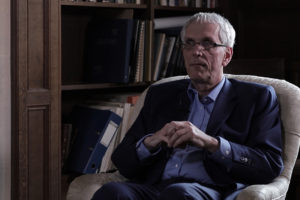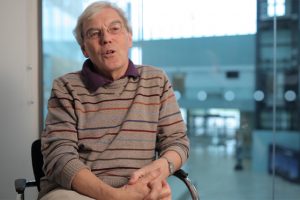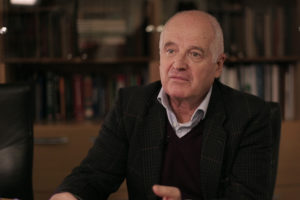Quantum Theory of Chemical Reactions
Chemist David Clary on quantum tunnelling, the rates of chemical reactions and how Schrödinger's equation help...
I’m going to talk about the Earth’s radiation budget, in particular, how radiation interacts with the surface. One of the reasons why this has become a very important topic is because the radiation that arrives at the Earth’s surface drives our climate: so it’s about understanding how much radiation arrives at the surface, what the nature of that is; obviously, we’re talking about radiation arriving from the Sun, coming through the atmosphere and interacting with the surface, so that’s the oceans, the atmosphere (obviously, that’s not part of the surface, but the atmosphere captures radiation and moves it around), and then the interactions with the surface part, in particular the vegetation: forests, crops, the stuff that drives pretty much all life on Earth and all the resources that we rely on for food and for shelter. Obviously, in the longer term, looking back, solar interaction with the surface has provided us with resources like fossil fuel resources.
So understanding how radiation arriving from the Sun and interacting with the Earth system is a crucial part of climate and also the biogeochemical cycles, the cycles that underpin life on Earth, obviously, is very important to us.
We are part of that life on Earth, and as we all know, we’re having a significant impact on that through all sorts of things: through fossil fuel emissions, through land-use change, through intensive agriculture. So all of those things link back to understanding how much light arrives at the surface, what the properties of that light are, and how it interacts with the Earth system.
The surface of the Sun is at around 6,000 K, and it emits radiation across the ultraviolet into the visible part of the spectrum, into the shortwave infrared, and then the thermal infrared part of the spectrum and longer wavelengths. This is a spectrum, which means it’s a continuous distribution of radiation coming from the Sun. That distribution is described by what we call a ‘blackbody energy distribution’. Theoretically, what that means is we consider the Sun to be a blackbody; all the radiation that falls upon a blackbody is perfectly absorbed and then perfectly reemitted. The reason why we use that approximation is that it allows us essentially to calculate the amount of energy that’s being emitted in this distribution at every different wavelength along this spectrum, and then we sort of divide that spectrum up and give it names. So those names are arbitrary; it’s a continuous distribution, but we call different bits of it different things.
Let’s focus on one very important bit of it to us that we call the visible. The reason why we call it visible is because we can see it, so our eyes are sensitive to a very, very narrow part of the spectrum. If we consider radiation coming from the Sun to be distributed from about 0.2-0.3 microns (millionths of a metre) to many centimetre wavelengths, our eyes are sensitive to a tiny, tiny part of that, from about 0.4 to about 0.7 microns. So it’s a tiny fraction of this overall spectrum, but it’s a bit that we’re sensitive to.
One question that you ought to be asking yourself is why are we sensitive to that bit as a spectrum?
Why is it so important to us? Why have we evolved eye systems that are very sensitive to this tiny part of the spectrum? And it’s not just us, so photosynthesis is also driven by this tiny fraction of radiation in this very very long spectrum. So why just this part of the spectrum? The reason is that when we look at this energy distribution (it is described by something called the Planck function), it has a very, very sharp peak. That peak (not coincidentally) is right in the visible part of the spectrum, so the peak of solar radiation is this very, very narrow range of wavelengths. So when you look at the distribution of the Sun’s radiation overall, if you’re going to evolve a system to be sensitive to a chunk of that spectrum, one chunk to be looking at is the visible part because there is this massive peak of energy there. So, if we sum this up, basically about 40% of the total solar energy is crammed into this 0.4-0.7 micron little tiny slice. Yes, 60% of the sun’s energy is elsewhere, but it’s spread over a much much wider range of wavelengths, a huge range of wavelengths.
Sunlight can interact with clouds (water vapour), it can interact with other gases, oxygen, ozone, carbon dioxide, carbon monoxide, methane and various other species and dust and soot as well. How much of that radiation gets through depends on what the atmosphere is made of. There are parts of the spectrum that we call atmospheric windows: what that means is the atmosphere is largely transparent to radiation coming through at those wavelengths. There are large parts of the Sun’s spectrum that arrive at the top of the atmosphere that don’t get through because it’s absorbed by gases and water vapour in the atmosphere.
So it just turns out that there’s a really narrow window in the spectrum right around where the peak of the Sun’s radiation is. That’s fortunate for two reasons.
The Sun’s radiation peaks at 0.4-0.7 microns, and at 0.4-0.7 microns there’s a hole in the atmosphere which allows that radiation through to hit the surface, to be absorbed by plants, to warm up the surface, to evaporate water and to heat the bottom of the atmosphere and drive the whole climate.
So, this combination of a peak in the Sun’s radiation and the atmospheric window then determines what we see here at the bottom of the atmosphere. So we look out the window on a sunny day, and we see that the sky is blue or it’s cloudy; that radiation has to have got through the atmosphere.
So anything that’s going to be evolved to survive on the Earth’s surface has to be sensitive to those things. You go very slightly shorter wavelengths to the ultraviolet, things that our eyes are not sensitive to, but ultraviolet radiation has higher energy; that radiation is potentially very damaging to the tissues of plants and animals; it’s what gives us skin cancer. So you only need to shift to shorter wavelengths from the visible, and you get to the ultraviolet. What protects us there is the ozone in the atmosphere that absorbs most of the ultraviolet radiation coming from the Sun – or it did until we realized that the CFCs, chlorofluorocarbons that we put in the atmosphere, was generating an ozone hole, it was decomposing the ozone and allowing more UV radiation through. So, the composition of the atmosphere, the distribution of the Sun’s radiation, determines entirely what we see here at the bottom of the atmosphere.

Chemist David Clary on quantum tunnelling, the rates of chemical reactions and how Schrödinger's equation help...

Molecular Biologist Richard Henderson on the lipid bilayer, mitochondria, and the evolution of organisms

Chemical physicist Alexey Kornyshev on metamaterials, plasmonics and Raman scattering